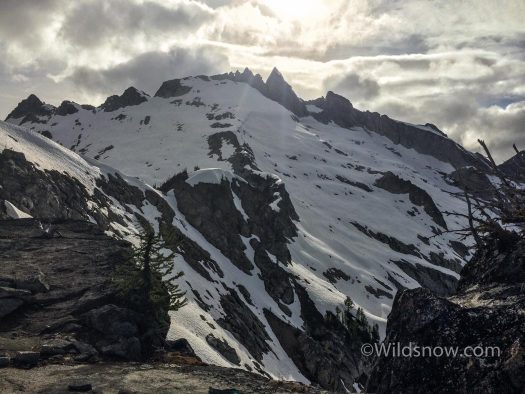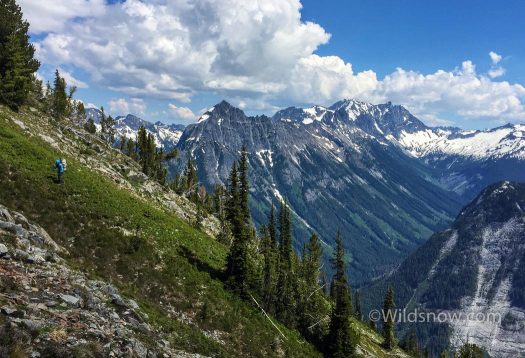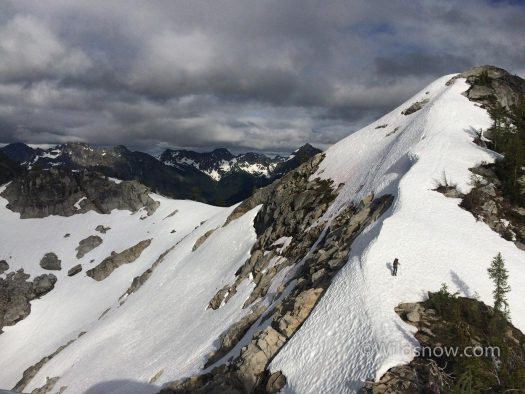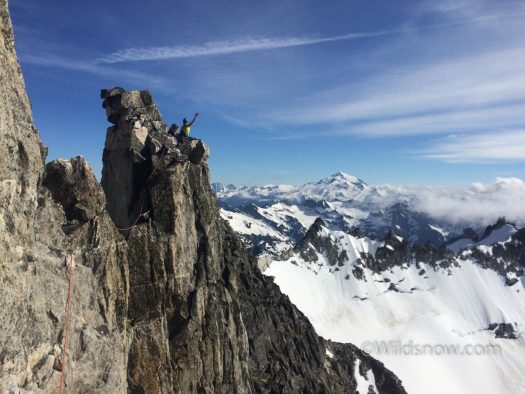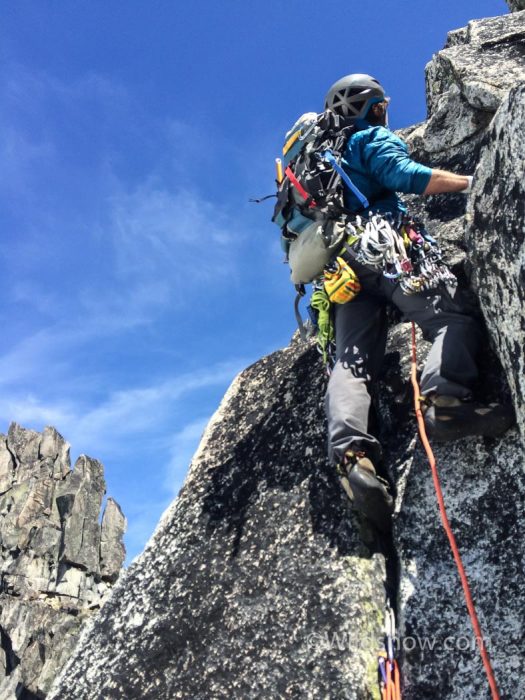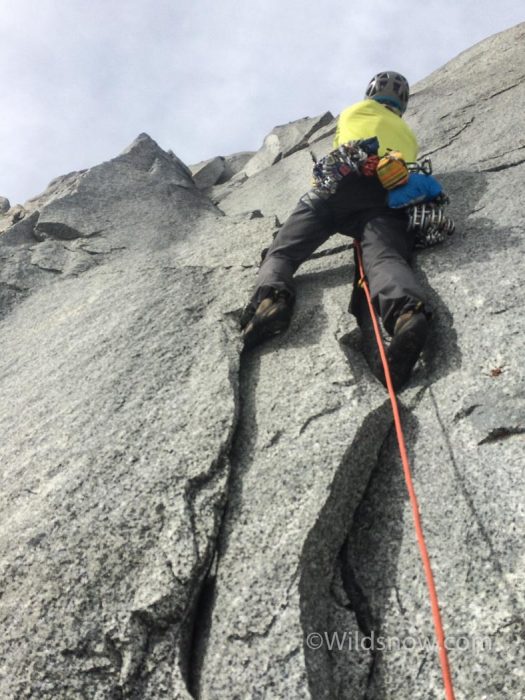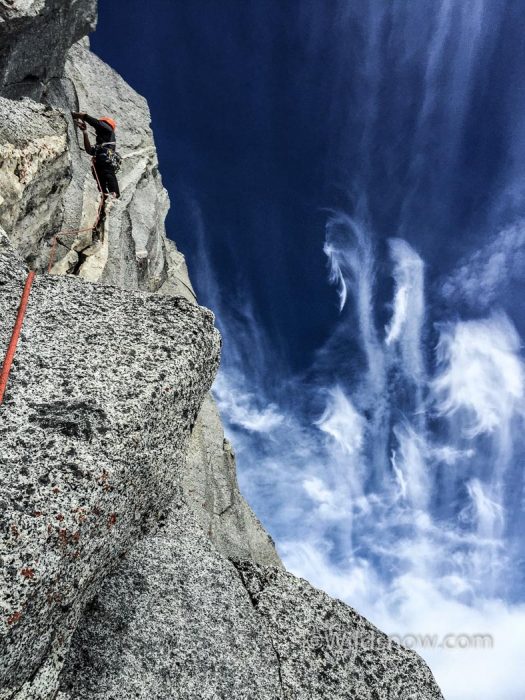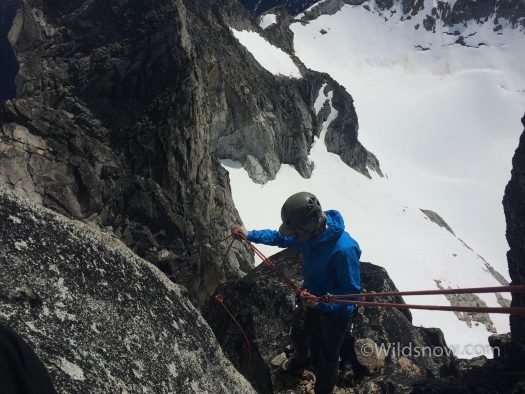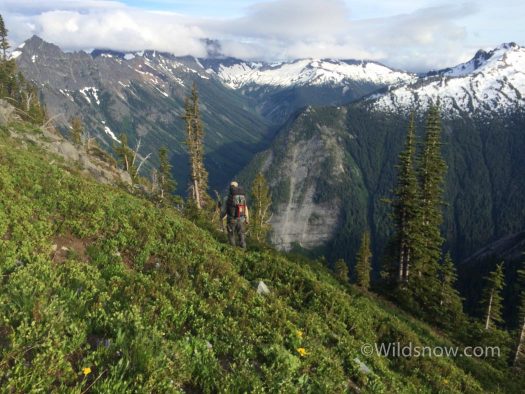Washington’s Cascades have some of the best alpine rock climbing in the country, one of the reasons I love living here. The Cascades are also one of the most rugged and inaccessible ranges in the lower 48. Consequently most climbing happens at a few areas that have easy access; mainly Washington Pass and Cascade Pass. I’ve been guilty of only picking the low-hanging fruit of alpine rock, shying away from anything with more than a few hours approach.
The plums of the Gunsight peaks aren’t low-hanging. The granite spires are protected by a 2-day approach that involves miles of hiking and several thousand feet of Cascade bush-wacking. This gives the towers an element of mysterious attractiveness.
Additionally, claims of “the best rock in the Cascades”, and “Patagonia quality” piqued my interest. My good friend and fellow suffering aficionado, Cooper, wanted to make a trip to explore the range. The week before the 4th of July the weather looked good, I was down.
After a 4am wakeup in Seattle, and a few wrong turns, I pulled into the Fields Point Ferry terminal just before the daily departure. I quickly threw the remaining pieces of gear into my pack, and we walked onto the Lady of The Lake.. Although I’ve lived in Washington for years, I’ve never ventured up Lake Chelan, the 3rd deepest lake in the U.S. The 3 hour ride was beautiful; the steep shoreline gradually transitioned from desert scrubland to dense, evergreen forests. In Stehekin, after a quick stop for delicious treats at the Stehekin Pastry Company, we boarded a Park Service bus that would take us to the trailhead.
That evening, after a long trip via car, boat, bus, and foot, we rolled into our campsite about six miles up the Pacific Crest Trail. The next morning we hiked a few more miles up the trail, then ventured off into the underbrush. The bushwhack took most of the rest of the day.
After hours of struggling through the heat, we broke through the trees, and found easier travel in the alpine. A few hours of snow hiking followed. I decided to bring approach shoes on this trip, and after slipping around on the snow under the weight of my heavy pack, I was regretting my decision. We made camp on a beautiful exposed rock ridge, above Blue Glacier.
The next morning found both of us tired, and since we hadn’t done much climbing this spring, we decided to try two of the easier routes. We hiked around to the west side of the towers, and started up the classic SW ridge of the highest peak in the range, the Middle Gunsight. The route started off with loose blocky climbing, but the last two pitches held wonderful easy climbing up cracks and knobs on an exposed ridge. The routes in the Gunsight range are all quite short, this one being about 5 short pitches. We reached the top quickly, and rappelled down the other side. After a bit of lounging on warm rocks, we headed toward the “Cannon Hole route”.
The Cannon Hole is a natural arch between two of the smaller towers in the southern end of the range. It’s a striking feature, especially since it was formed in a rockfall event only 30 years ago, and the rest looks like it will collapse any day. The climb was only 3 pitches, with marginal rock quality. However, walking over the Cannon Hole was unique (if a bit nerve-racking).
The climbs of the day felt good, and we decided to go for our ultimate goal on the next day: the stellar east face of the Middle Peak. This is what we came for. The “Patagonia-like” granite purportedly makes this climb one of the best in the Cascades. I was a bit nervous beforehand, owing to our remoteness and the difficulty of the route. I also had a few bad dreams of falling and other climbing accidents. Not good for personal moral. When we got on the rock, however, it proved to be an awesome climb.
We made our way up the rock, and enjoyed incredible pitches of clean granite climbing. The route was one of the remotest, seldom traveled routes I had ever been on. It felt like we were the first people there, and the only people as far as we could see.
We made our way back to camp around mid-afternoon. Lounging in the afternoon sunshine, the conversation turned toward the way out. Our schedule was dictated by the Stehekin ferry and bus schedule. In short, we had to be at the trailhead by 9am in order to catch the “fast” ferry back to our cars. We had two options: rally that evening, and try to get to the trailhead by 9 am the next morning, or get there a bit later, and have a relaxed day of hanging out on the lake in Stehekin. However, we were excited to get back to a hot shower, and enjoy the rest of the 4th of July holiday.
We decided to go for it; the conversation went something like this:
“You know this is going to really suck, right?”
“Yep, it’s gonna be heinous.”
“Okay, let’s do it.”
After packing up, we started the journey about 6pm. We knew it would get dark a bit after 9, and we wanted to get thru the bushwacking before night fell. We got past the snow and the alpine rock scrambling fairly quickly, and were hopeful that we’d reach our goal. As we ventured below treeline, however, we found ourselves in the midst of a 5-star PNW bushwack. For the next several hours we slipped, stumbled, and cursed our way down steep hillsides. To make matters worse, the bugs were horrible and we were already beat from the long day of climbing.
Darkness fell as we were still several thousand feet above the valley floor. Eventually we made it back to the trail. We hiked a few miles further, then set up camp and slept for a few hours. We woke at 4, determined to hike the last six miles and catch the 9am bus to Stehekin. I tried to hike fast, but my knees, feet and legs were worked. I hobbled into the trailhead a few minutes before the bus pulled away.
Here’s a little taste of the bushwack descent:
Note: Apologies for the low picture quality. I brought my “big camera” on the trip, but my charging setup didn’t work, so after it quickly drained the one battery I brought, I had to resort to iPhone photography.
Louie Dawson earned his Bachelor Degree in Industrial Design from Western Washington University in 2014. When he’s not skiing Mount Baker or somewhere equally as snowy, he’s thinking about new products to make ski mountaineering more fun and safe.

